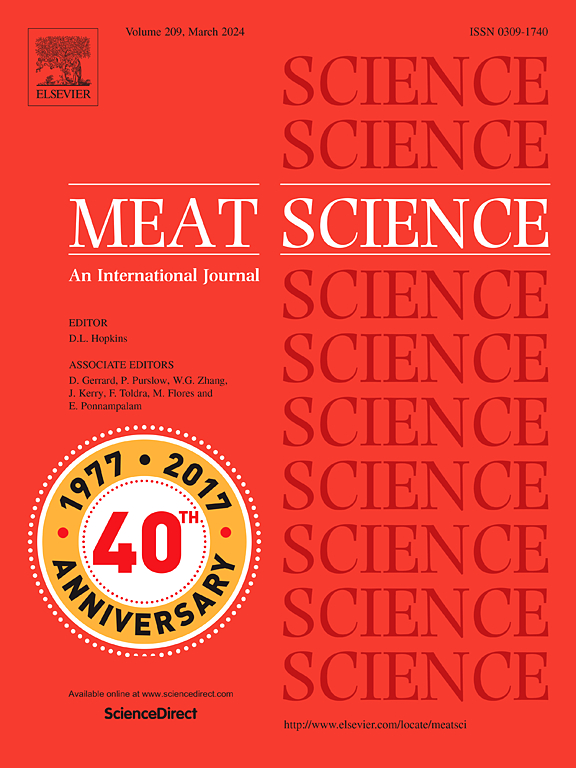Productive performance and meat nutritional and sensory characteristics of rabbits fed alfalfa-based diet
IF 6.1
1区 农林科学
Q1 Agricultural and Biological Sciences
引用次数: 0
Abstract
Current rabbit production faces sustainability challenges due to its dependence on conventional feed ingredients (i.e., corn, wheat, soy), which are responsible for price volatility, feed and food competition and environmental impacts. In this context, the interest in forage use (i.e., alfalfa), has increased. The aim of this trial was to evaluate the effect of an alfalfa-based diet on performance, Longissimus thoracis and Lumborum muscles (LTL) fatty acid profiles, oxidative status, nutritional and sensory characteristics (hind legs) of rabbit meat. Four hundred eighty Martini hybrid rabbits, 35 days old, of both sexes, were divided into two groups and fed commercial pelleted feed (Control group) or alfalfa-based feed (Alfalfa group), both for the postweaning (40.4 % alfalfa hay, 35.0 % dehydrated alfalfa) and fattening periods (35.2 % alfalfa hay, 30.0 % dehydrated alfalfa). All rabbits were slaughtered at 80 days, and 20 carcasses per group were collected. The Alfalfa group showed lower productive performance than the Control group did; however, the mortality rate was almost cut in half. No physical changes were detected in rabbit meat due to the dietary treatment, but the meat from the Alfalfa group was leaner and the lipid content was lower than those of Control group. Furthermore, the meat from the Alfalfa group of rabbits showed significantly higher PUFA n-3 and lower PUFA n-6 contents, maintaining a good oxidative status. Finally, the sensory analysis confirmed the absence of differences in the perception of the two types of meat by the consumer.
苜蓿饲粮对家兔生产性能及肉品营养和感官特性的影响
由于对传统饲料成分(即玉米、小麦、大豆)的依赖,目前的兔子生产面临着可持续性挑战,这些成分会导致价格波动、饲料和食品竞争以及对环境的影响。在这种情况下,对草料利用(即苜蓿)的兴趣增加了。本试验旨在评价苜蓿饲粮对家兔肉生产性能、胸腰最长肌(LTL)脂肪酸分布、氧化状态、营养和感觉特性(后腿)的影响。试验选用35日龄雄性马蒂尼杂交兔480只,分为2组,分别在断奶后(40.4%苜蓿干草,35.0%脱水苜蓿)和育肥期(35.2%苜蓿干草,30.0%脱水苜蓿)饲喂商品颗粒饲料(对照组)和苜蓿基饲料(苜蓿组)。80 d屠宰,每组取20只。苜蓿组的生产性能低于对照组;然而,死亡率几乎减少了一半。饲粮处理未对兔肉产生任何物理变化,但苜蓿组肉质较瘦,脂肪含量低于对照组。此外,苜蓿组家兔肉中PUFA n-3含量显著升高,PUFA n-6含量显著降低,保持了良好的氧化状态。最后,感官分析证实了消费者对两种肉类的感知没有差异。
本文章由计算机程序翻译,如有差异,请以英文原文为准。
求助全文
约1分钟内获得全文
求助全文
来源期刊

Meat Science
工程技术-食品科技
CiteScore
12.60
自引率
9.90%
发文量
282
审稿时长
60 days
期刊介绍:
The aim of Meat Science is to serve as a suitable platform for the dissemination of interdisciplinary and international knowledge on all factors influencing the properties of meat. While the journal primarily focuses on the flesh of mammals, contributions related to poultry will be considered if they enhance the overall understanding of the relationship between muscle nature and meat quality post mortem. Additionally, papers on large birds (e.g., emus, ostriches) as well as wild-captured mammals and crocodiles will be welcomed.
 求助内容:
求助内容: 应助结果提醒方式:
应助结果提醒方式:


